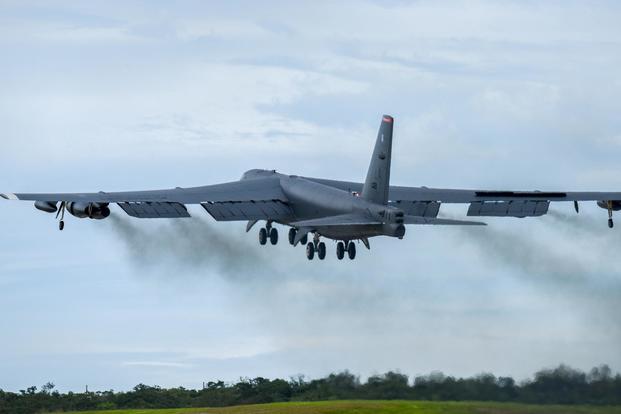The U.S. Air Force wants to get new engines for its heavy B-52 Stratofortress bombers as quickly as possible to keep the long-range aircraft flying for another 30 years. But lawmakers are insisting that service officials nail down contract specifics before they provide funding.
In a background briefing with reporters Monday, House Armed Services Committee staff members said that the Air Force first has to stipulate definitive requirements with defense companies before proceeding with a program.
The Air Force has said it will utilize its Section 804 Authorities Middle Tier Acquisition law authority, which includes new practices that streamline the process and push decisions down to program officers, to expedite new engines for the aircraft, known throughout the force as the BUFF, or "Big Ugly Fat Fellow."
"We're concerned that … by utilizing that authority, they're not doing their due diligence with regard to the requirements," said a committee staff member, referencing an early draft of the House Armed Services Committee defense bill.
Congress first authorized the practice in the fiscal 2016 National Defense Authorization Act.
Related content:
- B-52, Aircraft Carrier in Mideast over Iran Conduct Exercise
- Defense Department Awards Boeing $14.3B Bomber Maintenance Contract
- The Next B-52 Bomb Upgrade May Be a Tough Message for China
- Air Force Planning Shorter, More Frequent Strategic Bomber Rotations
"We're going to require that [the service] lock down the requirements, submit them to us, and let us know how they're going to test to those requirements before they receive the full amount of funding in FY20" budget, the staffer said.
The service has been pushing for a major engine overhaul for the bomber fleet, which it intends to keep flying into the 2050s. Each aircraft currently has eight Pratt & Whitney TF33-P-3/103 turbofan engines.
Air Force officials had hoped to release a Request for Proposal to defense companies this spring; it's unclear whether the House committee's demands will delay that.
"The Air Force Service Acquisition Executive designated the Commercial Engine Replacement Program (CERP) as a National Defense Authorization Act Section 804 Rapid Prototyping program on September 20th, 2018," according to the Air Force's Fiscal 2018 Annual Acquisition Report.
"Leveraging rapid prototype authorities removes 39 months from the CERP schedule," the report states, with production anticipated to begin in 2025.
The Air Force requested $70 million total toward the effort in its fiscal 2018 and fiscal 2019 budget requests for risk reduction and planning efforts, spokeswoman Ann Stefanek said Monday, adding that the service is currently requesting $175 million toward the re-engining program in its fiscal 2020 request.
Through its Future Years Defense Program, or FYDP, the service projects that it will spend $1.3 billion over the next five years on re-engining-related work.
"We've been talking about re-engining the B-52 for a long time," Lt. Gen. Jack Weinstein, then deputy chief of staff for strategic deterrence and nuclear integration, said last year. He has since retired.
But "every time you renovate a house, you don't realize there's asbestos behind the wall," he said, acknowledging the possibility that problems may develop as the service renovates the Cold War-era bomber.
"Am I going to sit here and say we're not going to have a problem with the re-engining? I'm not going to say that," Weinstein said at the time. "I will tell you an awful lot of work has gone into evaluating how to re-engine, what is the best way to do it, why we [decided] not to do a [service] life extension program on [a] really old engine ... so the work that has been upfront. It's going to take ... constant oversight as we go through the process."
The B-52, under Air Force Global Strike Command, has been prominent in missions such as Operation Desert Storm and Operation Iraqi Freedom, as well as the fight against the Islamic State in Iraq and Syria.
Most recently, B-52 bombers that deployed to the Middle East last month to counter unspecified threats from Iran have been conducting routine patrols over the Persian Gulf. A single bomber, alongside F/A-18 Super Hornets, MH-60 Sea Hawk helicopters and E-2D Growlers, conducted exercises with the Abraham Lincoln Carrier Strike Group in the Arabian Sea on Saturday.
The last B-52 rolled off the production line in 1962. The Air Force has 75 Stratofortresses.
-- Oriana Pawlyk can be reached at oriana.pawlyk@military.com. Follow her on Twitter at @Oriana0214.












